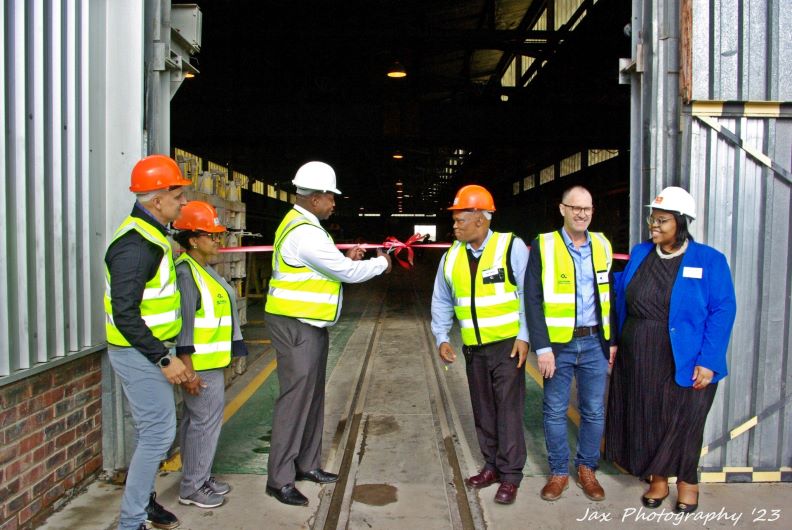
Colossal Concrete Products’ De Aar precast concrete manufacturing plant re-opened on 12 October. Having been spun off from Grinaker LTA, the company has a 64-year history as a prominent manufacturer of pre-stressed concrete railway sleepers – as well as other precast concrete products – in South and Southern Africa. This is Part 2 of a three-part article.
… continued from Part 1.
Kobus Burger, head of the company’s product research and development (R&D) and technical division, lists common challenges to the concrete design as being:
- the type and size of shutter / formwork; the handling, placing, and curing of concrete
- off-shutter requirements (concrete aesthetics) – including ensuring that there are no blemishes
- the type of equipment used (production and the transport of concrete)
- temperature variations which can influence the mix design, while there is also a winter and summer mix; and
- consistency in the supply of the quality of the of aggregates (grading, shape, dust content and excessive moisture content)
“We have found that the Chryso Premia range includes free-flowing polymers, which assist in the filling of shutters / moulds, with reduced energy (vibration) required.
“All of our products are produced in our Brakpan and De Aar manufacturing facilities. We have a focus on prestressed products such as poles, turnout sleepers and a wide range of open-track sleepers. These products are produced to very high specifications and differ completely from normal precast products, in that the production process is quite different and relies heavily on the bond between the wire or strand and the concrete. Although we also manufacture general infrastructure precast products such as culverts, pipes, secure enclosures – and various other products – our main expertise is in prestressed concrete products, and there is even one product where we first produce the prestressed elements and then combine these elements through post-tensioning,” says Burger.
Mahuma-Madida says the company has a meticulous process involving tensioning wires through stressing heads, thereby ensuring unparalleled strength and durability. The core market for these products is railway sleepers, with the manufacturing line extending its capabilities to concrete poles, masts, and specialised structures such as bridges.
Core to its growth has been a unique and sustainable system of modular, portable ‘project factories’ which it establishes near to a project site and near to raw materials, which reduces costs of transport. As a result of this strategy, Mahuma-Madida highlights that the company’s influence crosses national borders, for instance to Zimbabwe and Zambia, and thereby allowing it to make significant strides in establishing sustainable factories across the African continent, strategically positioned to cater to specific projects and then dismantled post-completion. She says the company has been approached for projects as far-reaching as Libya and middle and western Africa.
Klagsbrun notes that beyond its operational success, the company’s sustainable factory model, demonstrated in Zimbabwe and Zambia, showcases a commitment to responsible business practices. The ability to efficiently dismantle and relocate factories post-project, coupled with initiatives in diverse African nations, echoes the company’s alignment with a Pan-Africanist ethos.
“Having the necessary equipment and experience, this flexibility becomes a game-changer. European companies have expressed interest in our technology, recognising the challenges automated systems would face in remote areas with limited support.”
The company’s production process is characterised by its robustness and a deliberate reliance on a fairly labour-intensive approach. The reasoning behind this choice is twofold. “Firstly,” says Klagsbrun, “automation may not be viable in remote locations where breakdowns could paralyse operations. Secondly, there’s a commitment to job creation, acknowledging the responsibility to uplift local communities. The frequency of use depends on project size and volume. Smaller projects may render periodic usage impractical, while substantial projects make it economically feasible.”
Feasibility studies are critical ahead of locating a mobile factory. The key factors include transport cost, proximity to raw materials like cement and aggregates, and the overall demand projection.
A notable case study was in Namibia, where the company responded swiftly to a public sector commitment to build a new railway line. A small factory was set up in just three weeks to meet the urgent need for precast concrete sleepers. Moving beyond emergency scenarios, the company then established a larger factory in Namibia capable of producing 1 000 sleepers a day. The assessment of transport costs against the capital cost of a factory is the crucial factor in deciding the feasibility of a project.
While the company features the continent’s most extensive range of railway sleepers, its product portfolio extends further. Engaging with various industries, it supplies civil sector projects, provides poles and masts for the telecommunications and energy sectors, and contributes to the construction industry with products like culverts, curbs, and enclosures. Notably, these ventures span both private and government sectors.
Continued in Part 3…
More news
- CELEBRATING EXCELLENCE IN THE RESIDENTIAL PROPERTY SECTOR
- PART 4: GIBS PANEL DISCUSSES INTEMEDIATE CITIES ROLE IN AFRICA’S DEVELOPMENT
- EXPOSED AGGREGATE PAVERS COMPLEMENT NEW LIFESTYLE CENTRE
- GIBS PANEL EXPLORES ROLE OF INTERMEDIATE CITIES IN SA’S DEVELOPMENT PART 3
- CITI-CON’S CONCRETE KNOWLEDGE SUCCESSFULLY DEPLOYED ON NEW LANDMARK DEVELOPMENT





